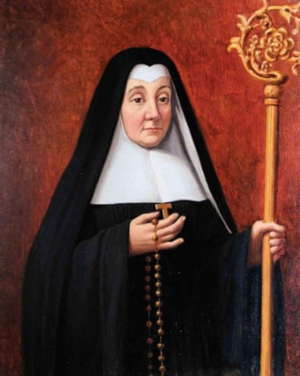Mary Joseph Butler facts for kids
Quick facts for kids Mary Joseph Butler |
|
|---|---|

3rd Abbess at Ypres
|
|
| Religion | Christian |
| Order | Benedictine |
| Institute | Abbey |
| Church | Our Lady of Grace, at Ypres, Flanders |
| Alma mater | Benedictine convent at Boulogne |
| Personal | |
| Nationality | Irish |
| Born | 1641 Callan, County Kilkenny, Ireland |
| Died | 1723 Ypres, Flanders |
| Senior posting | |
| Title | Dame, Nun, Abbess |
| Religious career | |
| Initiation | 4 November 1657 |
Mary Joseph Butler was an important Irish nun who lived a long time ago. She was born in Ireland in 1641 and passed away in 1723. She became the very first Irish Abbess (which is like the leader of a group of nuns) at a special place called the Benedictine Abbey of Our Lady of Grace in Ypres, Flanders.
Contents
Early Life of Mary Joseph Butler
Mary Joseph Butler was born in Callan, County Kilkenny, Ireland. Her aunt, Lady Abbess Knatchbull, was a leader at a Benedictine convent in Ghent. Mary was sent to live with her aunt for her education.
When Mary was just twelve years old, she asked if she could join the nuns. She was allowed to join two years later. On November 4, 1657, at the age of sixteen, she officially became a nun at the English Benedictine convent in Boulogne.
Becoming an Abbess in Ypres
In 1665, a new convent was started in Ypres, growing from the main convent in Ghent. Dame Beaumont was the first Abbess there. When she passed away in 1682, a big decision was made. The convent in Ypres would become a special place just for Irish Benedictine nuns.
So, Dame Butler was sent to Ypres in 1683. After the second Abbess, Dame Flavia Cary, died in 1686, Mary Joseph Butler was chosen as the new Abbess. She became the leader of the Irish nuns in Ypres on August 29, 1686.
The Dublin Convent Project
King James II wanted to start new religious communities in Ireland. He asked Abbess Butler to help create a new Benedictine convent in Dublin. King James gave this new convent, called "Gratia Dei," money every year. He also officially named Mary Butler as its first Abbess.
Abbess Butler's brother was a special helper to King James in Ireland. In 1688, Abbess Butler traveled to Dublin. She and her nuns even met the Queen, Mary of Modena, in London.
When they arrived in Dublin, they settled in a house on Great Ship Street. They started their daily prayers and opened a school. About thirty young girls from important families came to learn from the nuns. Many of these girls even wanted to become nuns themselves!
Challenges and Return to Ypres
However, their work in Dublin was stopped when soldiers entered the city after the Battle of the Boyne. The convent was attacked, and the nuns had to quickly find a safe place. A clever lay sister, Placida Holmes, saved many valuable church items. She dressed in regular clothes and mixed with the soldiers to hide the items.
Because of these troubles, the Dublin convent had to close. Abbess Butler's cousin, the Duke of Ormonde, offered to protect her if she stayed in Ireland. But she decided it was best to return to Ypres. The Duke helped her get a special pass to leave the country safely with her nuns.
Abbess Butler hoped to return to Ireland one day to restart the convent. But the community of nuns stayed in Ypres for the next 200 years.
Life Back in Ypres
The nuns returned to their home in Ypres. For a while, the convent didn't have much money. But around 1700, several new and wealthy women joined the community. They helped Abbess Butler keep the convent running well.
Abbess Butler continued to lead her nuns until she passed away in 1723. After her death, Margaret (Xaviera) Arthur became the new Abbess. Margaret was also an Irish nun who had joined the Ypres community in 1695.
The convent in Ypres managed to survive even the French Revolution, which was very rare. However, because of World War I, the community left Ypres in 1920. They moved to Kylemore Abbey in Ireland, where they still live today.

